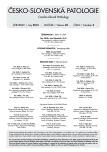Sequencing – classical method
Authors:
Monika Šedivcová 1; Petr Martínek 1; Jan Stehlík 1; Petr Grossmann 1; Jana Kašpírková 1,2; Tomáš Vaneček 1,2
Authors‘ workplace:
Bioptická laboratoř, s. r. o., Plzeň
1; Šiklův ústav patologie LF UK a FN, Plzeň
2
Published in:
Čes.-slov. Patol., 49, 2013, No. 3, p. 122-128
Category:
Reviews Article
Overview
In this article the basic methods of reading nucleotide sequences in DNA molecules are summarized. Sanger sequencing is described most thoroughly as it is the most frequent routine method currently being utilized. The article describes in detail the principle of sequence determination through the production of fragments with a known end base using chain termination synthesis of DNA and ways of separation and detection of the fragments. Some alternative methods of sequencing are mentioned in short. Basic approaches of analyzing sequence data are explained as well as different outcomes, obstacles and challenges.
Key words:
sequencing – Sanger – synthesis – ddNTP – fluorescence – capillary electrophoresis – mutation – electropherogram
Sources
1. Venter JC. The Sequence of the Human Genome. Science 2001; 291(5507): 1304–1351.
2. Sanger F, Nicklen S, Coulson R. DNA sequencing with chain-terminating inhibitors. Proc Natl Acad Sci 1977; 74: 5463–5467.
3. Maxam AM, Gilbert W. A new method for sequencing DNA. Proc Natl Acad Sci 1977; 74: 560–564.
4. Murphy KM, Eshleman JR. Simultaneous sequencing of multiple polymerase chain reaction products and combined polymerase chain reaction with cycle sequencing in single reactions. Am J Pathol 2002; 161(1): 27–33.
5. Smith LM, Fung S, Hunkapiller MW, Hunkapiller TJ, Hood LE. The synthesis of oligonucleotides containing an aliphatic amino group at the 5’ terminus: synthesis of fluorescent DNA primers for use in DNA sequence analysis. Nucleic Acids Res 1985; 13 (7): 2399–2412.
6. Skoog DA, Holler FJ, Crouch SR. Principles of Instrumental Analysis. 6th ed. Thomson Brooks/Cole Publishing: Belmont, CA 2007.
7. Shendure J, Ji H. Next-generation DNA sequencing. Nature Biotechnology 2008; 26: 1135–1145.
8. Huang XC, Quesada MA, Mathies RA. DNA sequencing using capillary array electrophoresis. Anal Chem 1992; 64: 2149–2154.
9. Franća LTC, Carrilho E, Kist TBL. A review of DNA sequencing techniques. Quarterly Reviews of Biophysics 2002; 35(2): 169–200.
10. Rohlin A, Wernersson J, Engwall Y, Wiklund L, Björk J, Nordling M. Parallel sequencing used in detection of mosaic mutations: comparison with four diagnostic DNA screening techniques. Hum Mutat 2009; 30(6): 1012–1020.
11. Pfeifer JD, Arber DA, Fuller ChE, et al. Molecular Genetic Testing in Surgical Pathology. Philadelphia: Lippincott Williams & Wilkins 2006; 89–90.
12. Dietrich J, Schmitt P, Zieger M, et al. PCR performance of the highly thermostable proof-reading B-type DNA polymerase from Pyrococcus abyssi. FEMS Microbiol Lett 2002; 217: 89–94.
13. Do H, Dobrovic A. Dramatic reduction of sequence artefacts from DNA isolated from formalin-fixed cancer biopsies by treatment with uracil- DNA glycosylase. Oncotarget 2012; 3(5): 546–558.
14. DNA sequencing by capillary electrophoresis. Applied Biosystems Chemistry Guide. Second Edition. 2009; Part Number 4305080. Rev. C. 05/2009.
15. Coleman WB, Tsongalis GJ. Molecular Diagnostic For the Clinical Laboratorian. Second Edition. Humana Press Inc. Totowa, New Jersey 2006: 89–102.
Labels
Anatomical pathology Forensic medical examiner ToxicologyArticle was published in
Czecho-Slovak Pathology

2013 Issue 3
Most read in this issue
- Polymerase chain reaction: basic principles and applications in molecular pathology
- Sequencing – classical method
- Next-generation sequencing
- Giant cell interstitial pneumonia without exposure to hard metals
